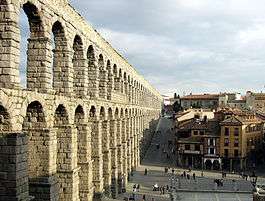Gadara Aqueduct
The Gadara Aqueduct, also called Qanat Fir'aun (Pharaoh's Watercourse), was a Roman aqueduct water supply for some of the Decapolis Cities. It serviced Adraha (known today as Dera'a in Syria), Abila (Decapolis) at Wadi Queilebh in Jordan, and the city of Gadara (modern-day Um Qais in Jordan).[1] The aqueduct has the longest known tunnel of the Classical Era.
There was one section of more than 106 kilometres (66 mi), constructed with Qanat technology. In this special case, nearly all the shafts were diagonal at 45-60 degrees, with stairs to the real water channel inside the mountain. The line went along steep slopes and collected water from sources around the area. The first visitor who rode along the "Kanatir" was U. J. Seetzen in 1805.
There are gradients of 0.3 metres per mile (0.2 m/km; 1.0 ft/mi) for the tunnel section. The aqueduct starts at a Roman dam in Dilli. From there, this part of the aqueduct line crosses several Wadis via five-to-ten-metre-high (15–35 ft) bridges. During the last few decades, more than three kilometres (2 mi) of the remaining substructions were demolished on the Plains between Dilli and Deraa near the Jordanian Border.
East of Adraha was a 35-metre (115 ft) bridge. The remains of the bridge now can be found on the ground of the new Al Saad Dam located at the eastern suburbs of Dera'a. After a junction point with a side channel from the Muzayrib lake, the underground aqueduct begins. Near Gadara (Umm Qais), three different water systems have been found. The first and second were built with Qanat technology and the 3rd[2] was built as a channel along a street. It is believed that all three systems were used, but each at a different period.[3]
Claims of underground city
Beneath the classical city of Adraha was an underground city, and was also part of the aqueduct. The inhabitants of the city collected water by jars on ropes, from the underground channel. Today, however, there is no sign of the "underground city" which was described by Wetzstein in 1860 and G. Schumacher in 1896.
See also
- Decapolis
- List of aqueducts in the Roman Empire
- List of Roman aqueducts by date
- Ancient Roman technology
- Roman engineering
References
- Döring, Mathias; Radler, Siegfried (2015), "Stau- und Wasserkraftanlagen", Taschenbuch der Wasserwirtschaft, Springer Fachmedien Wiesbaden, pp. 637–721, doi:10.1007/978-3-8348-8216-5_11, ISBN 9783528125806
- Mathias Döring: "Qanat Fir'un - Documentation of the 100 Kilometres Aqueduct Tunnel in Northern Jordan. Annual of the Department of Antiquities of Jordan, Amman/Jordan 2009, pp. 153–165.
- "Qanat Fir'aun / Dekapolis Aquädukt | Qanat Fir'aun". www.dekapolis-aquaedukt.de (in German). Retrieved 2018-10-25.
Bibliography
- Mathias Döring: "Qanat Firaun. 106 km langer unterirdischer Aquädukt im nordjordanischen Bergland, Schriften der Deutschen Wasserhistorischen Gesellschaft, Vol. 10 (2008), pp. 1–16
- Mathias Döring: "Wasser für die Dekapolis - Jordanisches Bergland birgt längsten bisher bekannten Aquädukttunnel. Ein Zwischenbericht. Deutsches Archäologisches Institut, Forschungs Cluster 2, Berlin 2012, 225-243.
- Mathias Döring: "Wasser für die Dekapolis. Römische Fernwasserleitung in Syrien und Jordanien. Deutsche Wasserhistorische Gesellschaft Vol. S 12, 2016, pp. 1–248, ISBN 978-3-9815362-3-2.
- Mathias Döring: "Roman Water Systems in Northern Jordan", Proceedings of the 12th International Congress on the History of Water Management and Hydraulic Engineering in the Mediterranean Region (Ephesus, Oct. 2004), Österreichisches Archäologisches Institut, Sonderschriften, Vol. 42 (Leuven, 2006), pp. 237–243
External links
- Rome's tremendous tunnel. The Ancient World's Longest Underground Aqueduct, Spiegel Online
- , Qanat Fir'aun, the more than 150 km long Decapolis Aqueduct in Syria and Jordan, Jens Kleb
International
- Gadara (Jordan), romanaqueducts.info
